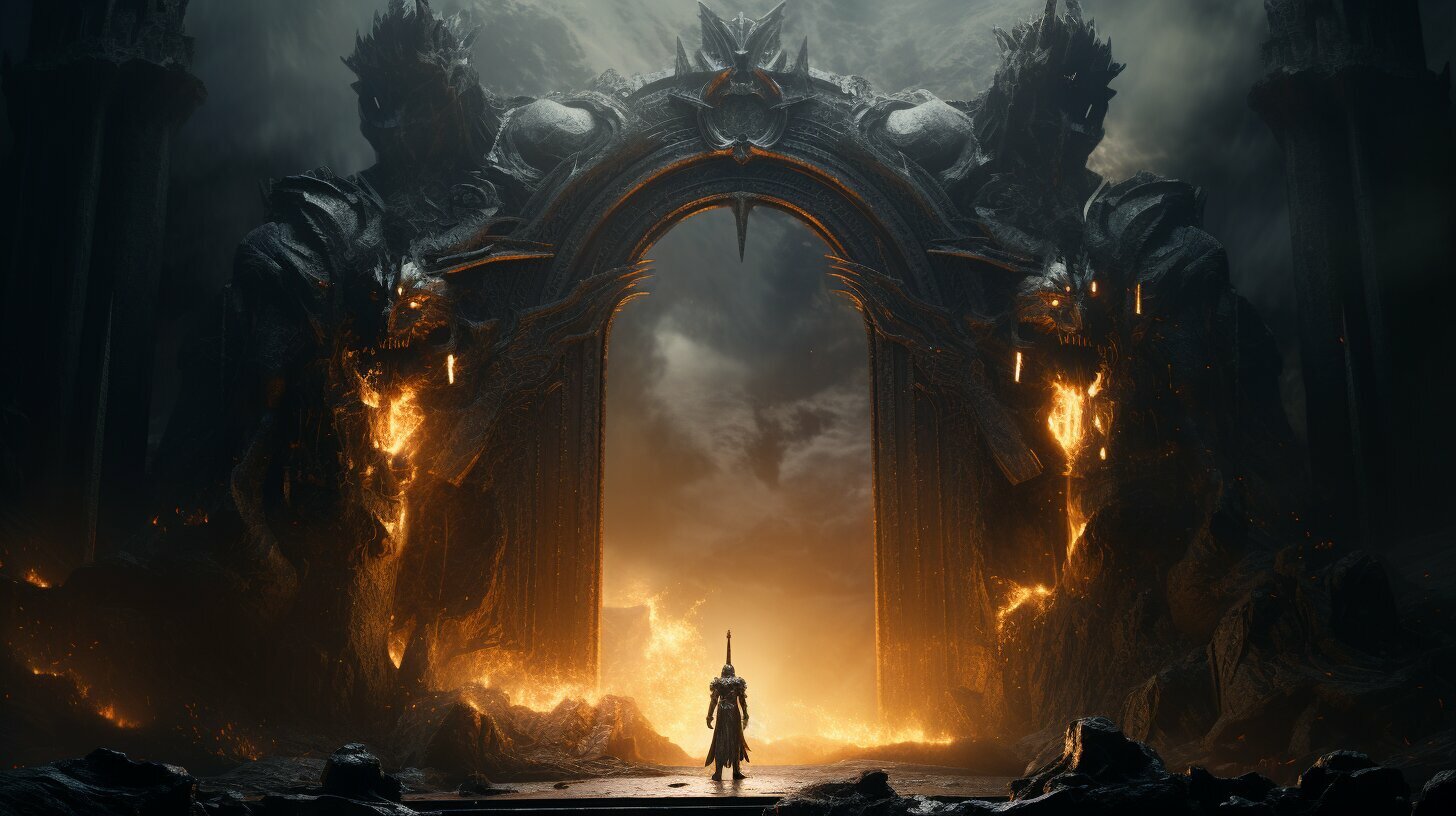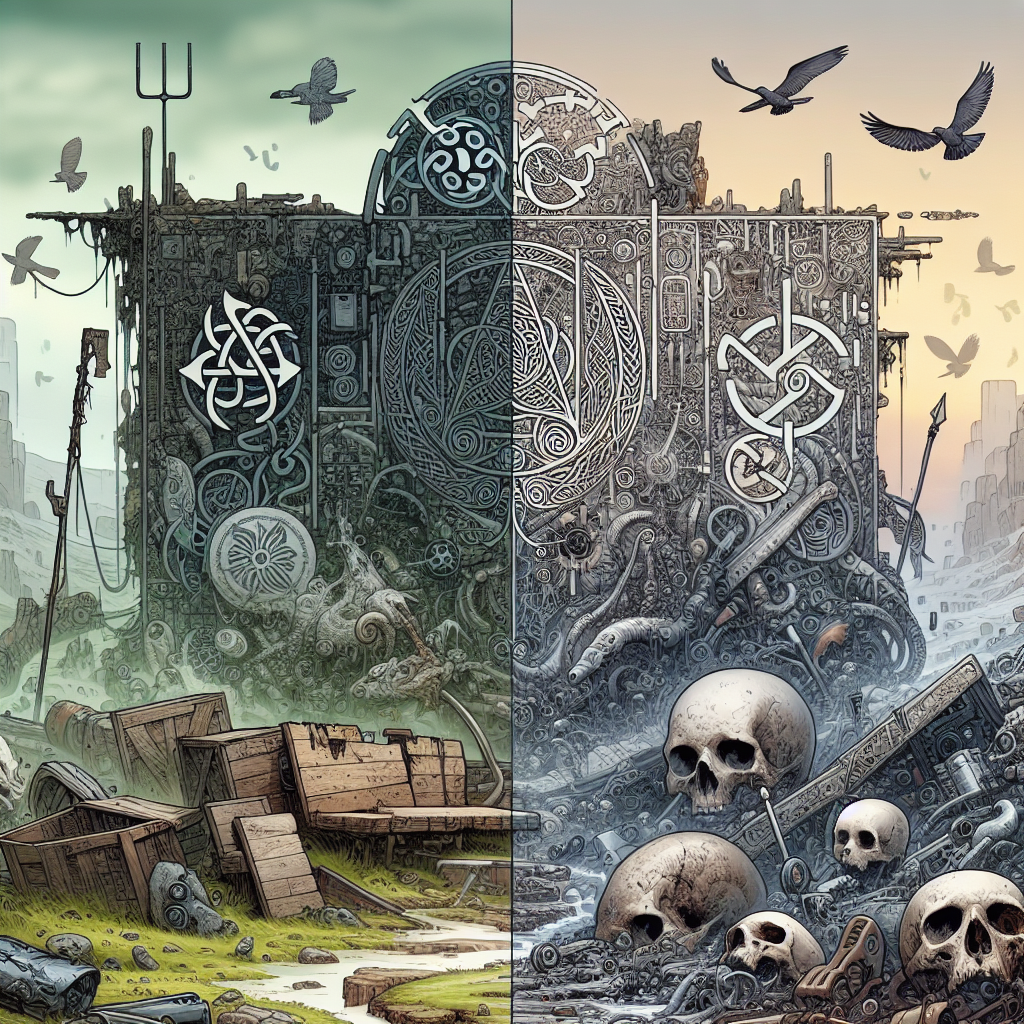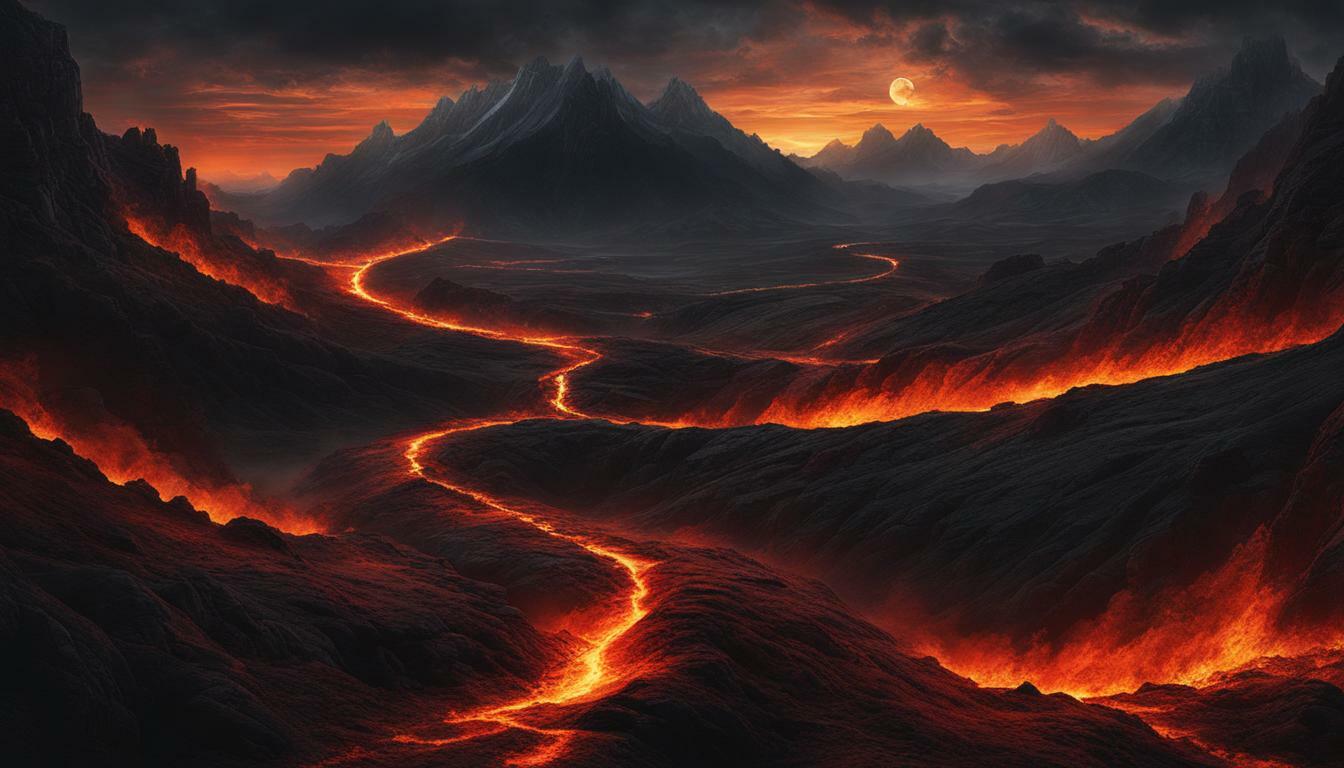Greek mythology and Norse mythology offer fascinating insights into different cultures’ beliefs about the afterlife. In this article, we will delve into the key contrasts between the Greek Underworld, known as Hades, and the Norse realm of the dead, called Hel.
In Greek mythology, the underworld is known as Hades and is ruled by the god of the same name. It is a complex realm with different regions for the souls of the dead, including the River Styx, the Elysian Fields, and Tartarus. Hades has had a significant influence on Western literature and philosophy.
In Norse mythology, the underworld is called Hel, and it is governed by the goddess Hel, who is the daughter of Loki. Hel is a cold and dreary place, often depicted underground. It is reserved for those who did not die a heroic or notable death. Hel has made its way into modern pop culture and is portrayed in various forms of media.
The difference between the Greek underworld and Norse Hel lies in their cultural contexts and depictions. While both realms are associated with death and judgment, they have distinct features and rulers. The Greek underworld has different regions and is ruled by the god Hades, while Hel is a specific realm governed by the goddess Hel. Both mythologies provide insight into different cultures’ perceptions of the afterlife and the unknown.
Key Takeaways:
- The Greek Underworld, known as Hades, and the Norse realm of the dead, Hel, have distinct differences in their cultural contexts and depictions.
- Hades, the ruler of the Greek Underworld, presides over different regions including the River Styx, the Elysian Fields, and Tartarus.
- Hel, governed by the goddess Hel, is a cold and dreary place reserved for those who did not die heroically or notably.
- Both mythologies offer insights into the beliefs and fears surrounding death and the afterlife in their respective cultures.
- Hades and Hel have had considerable influence on Western literature, philosophy, and modern pop culture.
The Greek Underworld: Hades and its Regions
According to Greek mythology, the Underworld, ruled by the god Hades, is a complex realm with various regions for the souls of the dead. It is a place where the deceased go to face judgment and spend eternity in different areas depending on their actions in life. Let’s take a closer look at the different regions within the Greek Underworld and their significance in Greek mythology.
One of the most well-known areas of the Greek Underworld is the River Styx. This dark river separates the realm of the living from the realm of the dead and is said to be a barrier that souls must cross to enter Hades’ domain. There is also the Elysian Fields, a paradise-like region reserved for the heroic and virtuous souls. It is a place of eternal bliss and happiness where the chosen few can enjoy their afterlife.
On the other hand, there is Tartarus, a deep abyss that serves as a prison for the most wicked and monstrous souls. It is a place of eternal punishment and suffering, reserved for those who committed heinous acts during their lives. Tartarus is often associated with torment and serves as a cautionary tale for mortals.
In addition to these regions, the Greek Underworld also encompasses other realms, such as the Asphodel Meadows, a neutral and nondescript area where ordinary souls reside. This region represents the average person’s afterlife and lacks the extremes of punishment or reward found in other areas.
In conclusion, the Greek Underworld, ruled by Hades, is a multifaceted realm with distinct regions for the souls of the dead. From the River Styx to the Elysian Fields and Tartarus, each area represents different aspects of the afterlife and serves as a reflection of Greek mythology and its beliefs surrounding death and judgment.
| Regions of the Greek Underworld | Description |
|---|---|
| River Styx | A dark river that separates the realm of the living from the realm of the dead |
| Elysian Fields | A paradise-like region reserved for heroic and virtuous souls |
| Tartarus | A deep abyss serving as a prison for the most wicked and monstrous souls |
| Asphodel Meadows | A neutral area where ordinary souls reside, lacking extremes of punishment or reward |
Norse Hel: The Cold and Dreary Realm
In Norse mythology, the realm of Hel is described as a cold and dreary place, reserved for those who did not meet heroic or notable deaths. It is often depicted as an underground realm, where the souls of the deceased reside. Unlike the Greek underworld, which has different regions for different types of souls, Hel is a specific realm governed by the goddess Hel, the daughter of Loki.
Hel is known for its desolate and melancholic atmosphere. According to Norse mythology, those who end up in Hel are not rewarded for their deeds in life and do not enjoy the same privileges as those who enter Valhalla, the hall of the slain. Instead, they are doomed to a gloomy existence, detached from the glory and honor that accompany heroic deaths.
The portrayal of Hel in Norse mythology reflects the cultural beliefs and fears of the Norse people surrounding death and the afterlife. The cold and dreary nature of Hel serves as a stark contrast to the vibrant, heroic afterlife of Valhalla. It represents a somber reality for those who did not achieve greatness in life and serves as a reminder of the harshness of fate and the inevitability of death.
In modern pop culture, Hel has become a popular subject of exploration and adaptation. It has made its way into various forms of media, including literature, films, and video games. Its desolate and ominous nature continues to captivate audiences, highlighting the enduring fascination with mythology and the afterlife.
Table: Comparison of Greek Underworld and Norse Hel
| Greek Underworld | Norse Hel |
|---|---|
| Has different regions for souls like the River Styx, Elysian Fields, and Tartarus | Hel is a specific realm without distinct regions |
| Ruled by Hades, the god of the Underworld | Ruled by Hel, the goddess and daughter of Loki |
| Associated with various myths and legends in Western literature and philosophy | Has influenced modern pop culture through its depiction in books, movies, and games |
While the Greek Underworld and Norse Hel share similarities in their association with death and the afterlife, they possess distinct characteristics shaped by their respective mythologies and cultural contexts.
The Rulers: Hades vs. Hel
The Greek Underworld is governed by the god Hades, while Norse Hel is ruled by the goddess Hel. Let’s explore the distinctions between these powerful figures. In Greek mythology, Hades is the god of the underworld, son of Cronus and Rhea. He is known as the ruler of the dead and the guardian of the souls that reside in his realm. Hades is often depicted as a stern and just figure, responsible for maintaining order in the Greek Underworld.
On the other hand, Hel, the ruler of Norse Hel, is the daughter of the mischievous trickster god Loki. She presides over a cold and gloomy realm reserved for those who did not die heroically or notably. Hel is often depicted as half-dead and half-alive, reflecting the duality of her realm. Unlike Hades, who is seen as a fair judge, Hel is often portrayed as more ambiguous and unpredictable.
Differences between Hades and Hel
While Hades and Hel both govern realms of the dead, there are notable differences in their characteristics and roles. Hades is associated with wealth and riches, which is reflected in the treasures he guards in the Greek Underworld. In contrast, Hel is the embodiment of death and decay, presiding over a desolate realm that mirrors her cold nature.
- Greek God of the Underworld – Hades
- Norse Goddess of the Underworld – Hel
Throughout mythology and literature, Hades has been depicted as a formidable and respected figure, while Hel is often portrayed as a more mysterious and enigmatic presence. Despite their differences, both rulers play important roles in their respective mythologies, shaping the beliefs and fears surrounding death and the afterlife in their cultures.
| Greek Underworld (Hades) | Norse Hel |
|---|---|
| Complex realm with different regions for souls | Cold and dreary realm for those who died without glory |
| Guarded by the god Hades | Presided over by the goddess Hel |
| Associated with wealth and treasures | Symbolic of death and decay |
Cultural Context and Depictions in Mythology
The Greek Underworld and Norse Hel offer captivating glimpses into the cultural perceptions of death, judgment, and the unknown. In Greek mythology, the underworld is known as Hades and is ruled by the god of the same name. It is a complex realm with different regions for the souls of the dead, each with its own significance. The River Styx serves as a boundary between the worlds of the living and the dead, while the Elysian Fields are a paradise reserved for heroes and those who have lived virtuous lives. Tartarus, on the other hand, is a place of punishment for the wicked. These distinct regions within the Greek underworld reflect the ancient Greeks’ beliefs and their emphasis on morality and divine justice.
In Norse mythology, the underworld is called Hel, and it is governed by the goddess Hel, daughter of Loki. Hel is often depicted as a cold and dreary place, located underground. It is reserved for those who did not die heroically or notably, contrasting with the Greek concept of a paradise for heroes. This portrayal of Hel reflects the Norse cultural emphasis on fate, where an individual’s actions in life determine their fate in the afterlife. Hel serves as a reminder of the consequences of a life lived without valor or distinction.
The depictions of the Greek underworld and Norse Hel in mythology have had a significant impact on Western literature, philosophy, and popular culture. The tales of Hades and his realm have inspired countless works of fiction and philosophical contemplation. One of the most famous examples is Dante Alighieri’s “Divine Comedy,” where the poet explores the various circles of Hell and incorporates elements from Greek mythology. Similarly, Norse mythology, including the realm of Hel, has influenced the works of authors such as J.R.R. Tolkien, who drew inspiration from Norse mythology in creating the world of Middle-earth.
The Cultural Significance of Greek Underworld and Norse Hel
Both the Greek underworld and Norse Hel provide insights into the cultures’ beliefs about the afterlife and the unknown. The Greek underworld highlights the importance of living a virtuous life, with the promise of reward or punishment in the afterlife. In contrast, Norse mythology emphasizes the role of fate and the consequences of one’s actions, suggesting that even in death, individuals are accountable for their choices. These contrasting perspectives on the afterlife shed light on the cultural values and fears of the ancient Greeks and Norse, offering a glimpse into their understanding of mortality and divine judgment.
| Greek Underworld | Norse Hel |
|---|---|
| Complex realm with different regions | A cold and dreary place |
| Ruled by the god Hades | Governed by the goddess Hel |
| Emphasizes morality and divine justice | Highlights the role of fate |
Influence on Literature, Philosophy, and Pop Culture
The Greek Underworld, with its rich mythology, has had a significant impact on Western literature and philosophy, while Norse Hel has found its way into modern pop culture. In Western literature, the Greek Underworld has been a recurring theme, with famous works like Dante’s “Inferno” drawing inspiration from its vivid descriptions and intricate hierarchy of souls. The concept of the Greek afterlife, with its various realms and the notion of judgment, has also influenced philosophical discussions about morality, justice, and the nature of the soul.
On the other hand, Norse Hel has resonated with modern pop culture in different ways. The gloomy and bleak depiction of Hel as a cold and dreary place has captured the imagination of artists, filmmakers, and writers. It has provided a haunting backdrop for stories that explore themes of death, darkness, and the supernatural. From comic books to video games, the Norse concept of Hel continues to inspire and captivate audiences worldwide.
“The Greek Underworld represents a realm that is both feared and revered in Western culture,” says mythology expert Dr. Emily Collins. “Its influence on literature and philosophy can be seen in the exploration of moral dilemmas, the human condition, and the quest for knowledge and self-discovery. In contrast, Norse Hel offers a dark and mysterious allure that is often embraced in contemporary media, providing a rich source of inspiration for artists and storytellers.”
Table: Comparing Greek Underworld and Norse Hel
| Greek Underworld | Norse Hel |
|---|---|
| Complex realm with different regions | Specific realm for those who didn’t die heroically or notably |
| Ruled by the god Hades | Governed by the goddess Hel |
| Associated with diverse afterlife beliefs in Greek culture | Reflects the Norse concept of death and its implications |
Conclusion
In conclusion, the Greek Underworld and Norse Hel offer distinct depictions of the afterlife, reflecting the beliefs and fears of their respective cultures.
In Greek mythology, the underworld is known as Hades and is ruled by the god of the same name. It is a complex realm with different regions for the souls of the dead, including the River Styx, the Elysian Fields, and Tartarus. Hades has had a significant influence on Western literature and philosophy. The Greek underworld is associated with a sense of justice and punishment, with souls being judged and placed in different realms based on their actions in life. It represents a complex and nuanced understanding of the afterlife.
In Norse mythology, the underworld is called Hel, and it is governed by the goddess Hel, who is the daughter of Loki. Hel is a cold and dreary place, often depicted underground. It is reserved for those who did not die a heroic or notable death. Unlike the Greek Underworld, Norse Hel is not depicted as a place of punishment, but rather as a final resting place for ordinary people. Hel has made its way into modern pop culture and is portrayed in various forms of media, often emphasizing its desolate and chilling nature.
The difference between the Greek underworld and Norse Hel lies in their cultural contexts and depictions. While both realms are associated with death and judgment, they have distinct features and rulers. The Greek underworld has different regions and is ruled by the god Hades, while Hel is a specific realm governed by the goddess Hel. Both mythologies provide insight into different cultures’ perceptions of the afterlife and the unknown, offering contrasting perspectives on the ultimate fate of human souls.
FAQ
Q: What is the difference between the Greek Underworld and Norse Hel?
A: The Greek Underworld, known as Hades, is ruled by the god of the same name and has different regions for the souls of the dead. Norse Hel, on the other hand, is a specific realm governed by the goddess Hel and is reserved for those who did not die heroically or notably.
Q: Who is the ruler of the Greek Underworld?
A: The Greek Underworld is ruled by the god Hades.
Q: Who is the ruler of Norse Hel?
A: Norse Hel is governed by the goddess Hel, who is the daughter of Loki.
Q: What are the main regions within the Greek Underworld?
A: The Greek Underworld consists of different regions, including the River Styx, the Elysian Fields, and Tartarus.
Q: How is Hel described in Norse mythology?
A: Hel is described as a cold and dreary place often depicted underground.
Q: How do the Greek Underworld and Norse Hel reflect their respective mythologies?
A: The Greek Underworld and Norse Hel provide insights into their cultures’ beliefs and fears surrounding death and the afterlife. They reflect the cultural contexts and depictions of each mythology.
Q: How have the Greek Underworld and Norse Hel influenced literature, philosophy, and pop culture?
A: The Greek Underworld and Norse Hel have had a significant impact on Western literature and philosophy. They have also made their way into modern pop culture and are portrayed in various forms of media.
 Skip to main content
Skip to main content


